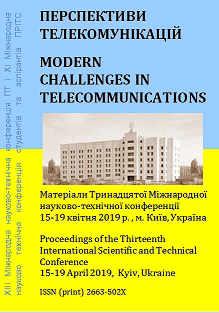ВИКОРИСТАННЯ SDR ТРАНСИВЕРА BLADERFx40 ДЛЯ ФОРМУВАННЯ СИГНАЛІВ ЦИФРОВОГО ТЕЛЕБАЧЕННЯ СТАНДАРТІВ DVB-S ТА DVB-S2
Ключові слова:
Трансивер, програмно конфігуроване радіо, модуляція, супутникове телебачення.Анотація
Bladerfx40 SDR transceivers application for digital TV DVB-S and DVB-S2 standards signals generation
The current state of telecommunication development is characterized by the usage of Software-Defined Radio (SDR). Currently, the most used SDRs are RTL2832U, HackRF, Airspy, BladeRF, SDRPlay RSP. The easiest way to study SDR programming is to use the GNURadio program. In this thesis, the generation of DVB-S and DVB-S2 signals in GNRadio is considered. This thesis will be useful for radio amateurs and developers of television equipment.
Сучасний стан розвитку телекомунікацій характеризується використанням програмно конфігурованого радіо (SDR). На даний момент найбільш використовувані SDR є RTL2832U, HackRF, Airspy, BladeRF, SDRPlay RSP. Найбільш простим способом засвоїти програмування SDR є використання програми GNURadio. В данному тезисі розглядається формування сигналів DVB-S та DVB-S2 за допомогою трансивера BladeRFx40 та програмного пакету GNURadio.
Посилання
Бібліотека gr-osmosdr B210 [Електронний ресурс] – Режим доступу: https://packages.debian.org/ru/sid/gr-osmosdr.
Модуль GNURadio DTV [Електронний ресурс] – Режим доступу: https://github.com/gnuradio/gnuradio/tree/master/gr-dtv.
##submission.downloads##
Як цитувати
Номер
Розділ
Ліцензія
Авторське право (c) 2019 Євгеній Андрійович Літвінов, Гліб Леонідович Авдєєнко

Ця робота ліцензується відповідно до Creative Commons Attribution 4.0 International License.
Authors who submit to this conference agree to the following terms:a) Authors retain copyright over their work, while allowing the conference to place this unpublished work under a Creative Commons Attribution License, which allows others to freely access, use, and share the work, with an acknowledgement of the work's authorship and its initial presentation at this conference.
b) Authors are able to waive the terms of the CC license and enter into separate, additional contractual arrangements for the non-exclusive distribution and subsequent publication of this work (e.g., publish a revised version in a journal, post it to an institutional repository or publish it in a book), with an acknowledgement of its initial presentation at this conference.
c) In addition, authors are encouraged to post and share their work online (e.g., in institutional repositories or on their website) at any point before and after the conference.

